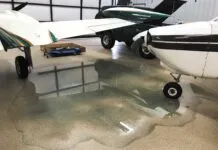With high expectations, we set out to bring you a comprehensive report on those parts of NextGen—the next generation of air traffic control—that are now up and running. Intensive internet research plus interviews with many FAA controllers, FAA engineers, vendors, consultants and even FAA administrator Randy Babbitt, showed otherwise.
Underneath the hype, NextGen really consists of five transformational technologies, only some of which are defined, let alone up and running. Here’s our best stab at NextGen’s status today and what we can expect in 2010.
What We Have Now
The most visible part of NextGen on line is the GPS WAAS LPV approach. There are about 1800 of these approaches now, and NextGen’s Implementation Plan calls for 500 new LPVs per year through 2012. FAA estimates that about 20,000 GA aircraft are presently equipped to fly an LPV approach.
We also have RNAV/RNP SIDs, STARs and Q/T-routes. Nearly half of all GA IFR aircraft are equipped with IFR-certified GPS navigation systems capable of flying RNAV routes.
There are two existing technologies that are being expanded to hook into NextGen. The first is ASDE-X, or Airport Surveillance Detection Equipment, Model X, an airport surface surveillance computer that melds surveillance data from multiple sources together to locate and identify aircraft and transponder-equipped vehicles on an airport movement area, as well as aircraft flying within five miles of the airport.
While the most common input is radar, ASDE-X accepts input from multilateration pseudo-radar sensors (Colorado recently got one of these pseudo-radar systems) and ADS-B Out.
The second technology is ERAM, or En Route Automation Modernization. ERAM permits three-mile separation instead of five, in some areas, and supports End-to-End Route Conversion. More fully explained in Charles D. Richardson’s article, “Baby Steps to NextGen” (October 2008 IFR), route conversion permits better routing even before you take off. ERAM is already working in six en route centers. In 2010 ERAM will become operational in the remaining 14.
NextGen’s centerpiece is ADS-B, or Automatic Dependent Surveillance-Broadcast. You can think of it as networked GPS. ADS-B Out (as in going out of your airplane) tells other airplanes and ATC your position, groundspeed, altitude and heading. ADS-B In delivers information to the cockpit, such as clearances, weather and where all those other airplanes are. ADS-B is partially available today, but the final ruling on acceptable compliance is still in the works (more on that in a minute).
One still-to-be-completed technology is System-Wide Information Management (SWIM). SWIM would enable all participants in the National Airspace System—pilots, controllers, airline dispatchers and others—to see the same pool of information at the same time, making collaborative decision-making possible. For example, users will see exactly the same weather, produced through a new weather model called the 4D weather cube.
NextGen will be rounded out with a critical controller-pilot data link and a new phone system for ATC.
ADS-B Equipage Mandate
In April, 2010, a final rule will likely mandate equipage with ADS-B Out by 2020 if you want to operate in Class A, B and C airspace, and Class E above 10,000 feet. ADS-B In will likely be optional. You’ll also need ADS-B Out to fly in and around the airports listed in FAR 91 Appendix D, but operating at larger airports will magnify the differences between ADS-B haves and have-nots long before 2020.
Four major rollouts are planned for ADS-B in 2010. Initial Operations Capability will be sought in the Gulf of Mexico; Juneau, Alaska; Philadelphia, Pa.; and Louisville, Ky. These sites will test ADS-B’s ability to work with other elements of Air Traffic Management software, a key component of NextGen.
In September 2010, the FAA will make a critical in-service decision: whether to proceed with the mass buildout of the remaining ADS-B ground stations—some 794 in all—or not.
If the decision is made to continue, the balance of the rollout is expected to be rapid. By 2011 we will likely be looking at ADS-B coverage throughout the CONUS and southern Alaska. This likely course of events means new avionics capabilities and options that will gradually transform IFR operations as we know them. ADS-B capability raises two issues: equipage and service-level expectations.
Suiting up for full ADS-B calls for at least a multifunction display, a proper GPS receiver and an ADS-B transceiver. That could be either a Universal Access Transceiver (UAT) or a 1090ES transceiver. For operations in Class A airspace, 1090ES functionality will be required.
If you already have an MFD and GPS, then the transceiver is your incremental cost. For instance, if you have a Garmin G1000, you need a GDL90 transceiver and perhaps a software upgrade. There has been some discussion about using the Mode S datalink in modern transponders instead of the transceiver to save money.
Estimates for equipage run between $8000 to $11,000 for ADS-B Out. Adding ADS-B In could tack on as much as $20,000. While the FAA is not expected to mandate ADS-B In, you won’t get the traffic and weather information in your cockpit without it. Before you gasp, these figures are loose estimates. A smart buyer will also leverage the required technologies to get the most bang for the buck. Spending a bit more might add WAAS GPS approach capability for instance. We think a smart government incentive program would create just these kind of carrots to offset the ADS-B mandate stick.
Each aircraft owner will have to decide what to do based on what, where, when and how they fly. For aircraft with older panels, retrofitting is hard but will add sustaining value to the aircraft. And good old VFR will still be with us.
Industry groups have recommended financial aid such as government subsidies, no- or low-interest loans and tax credits, a NextGen equipage bank and accelerating implementation (the “If you build it they will come” idea). Now Congress is asking, “How many jobs could it create?”
Who Goes First?
As GA pilots, one of our greatest concerns is potential exclusion from airspace and airports. First-come, first-served has worked well for years, and is even formally defined in the Controller’s Handbook (Paragraph 2-14).
“Best-equipped, best-served” or BEBS, has been its unspoken cohort for a long time. You need Mode C in some airspace, DME at or above FL240, RVSM above FL290, oxygen at higher altitudes and GPS to fly Q- or T-routes and employ direct-to area navigation. You get what you pay for. The FAA is proposing a wholesale evolution to BEBS, where best-equipped really means ADS-B equipped.
In the NextGen world you might not file /G or /A, but by RNAV performance level. At RNAV-2, you are within two miles of where you say you are 95 percent of the time, which is sufficient for en route ops. With RNAV-1 you can fly RNAV SIDs and STARs. At RNAV-0.3, you can fly complete approaches. But BEBS could take this further, offering operational carrots to ADS-B equipped aircraft, such as preferred airspace, routing, or runway access.
Although BEBS sounds simple in concept, its application is tricky. BEBS calls upon controllers and pilots to know when and where it’s in use. Controllers must know which aircraft are “best equipped” and how to apply BEBS consistently. What will the pecking order be as to who is best-equipped? Will there be a “better-equipped” in the middle? Will you have to send ATC a photo of your panel via data comm downlink in order to get the goodies? No one knows.
The National Air Traffic Controllers Association is concerned that BEBS might call for changes in automation displays (e.g., aircraft equipage levels appearing as additional cluttering information on a controller’s scope) and extra controller training. BEBS will surely complicate traffic flows into airports if the controller is supposed to place the twelfth airplane in line first because it has the right gear on board.
It’s still early days for NextGen, but 2010 will be pivotal. By the FAA’s timetable, full deployment of NextGen will be upon us by 2025. See you there.
Fred Simonds is a Gold Seal CFII. See his web page at www.fredonflying.com.




